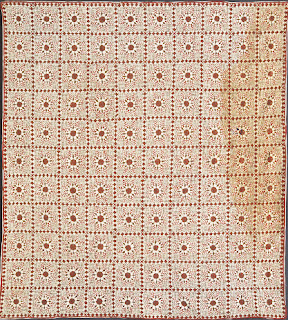Martha A. Haggard, White Cloud, Kansas.
Carpenter's wheel pattern, estimated date 1895-1897.
Collection of the Spencer Museum of Art
Gift of Mr. and Mrs. Clark Langworthy
I am giving a talk for my guild this week on quilts in the
collection of the Helen F. Spencer Museum of Art at the University of Kansas.
Spray-painted quilts on the grass a few years ago.
Thanks exhibits team!
I am honorary quilt curator---
and over the past thirty years or so I've catalogued the quilts and curated several exhibits from their fabulous collection. The museum is closed for renovation this year but I am looking forward to the re-opening in 2017. We'll have new storage and exhibit spaces.
I know the quilt collection well, but I have taken some time the past few weeks to explore the internet for quiltmakers' biographies. Genealogy that took me weeks to find twenty years ago is easy to update in an hour or two.
Martha Kington Haggard
(1815-1900)
I'm not positive this is her.
My favorite new revelation is about Martha Kington Haggard. Besides learning how to spell her maiden name----it's the unusual Kington rather than Kingston---I found out more about her personality.
She was born in Virginia; died in Kansas.
An ad for the Haggard store in 1867
Spencer has only one quilt by Martha Haggard in the collection. But it's a favorite.
We call it the Wonder Quilt (I don't quite know why but it is certainly wondrous.)
On the reverse it is has a stamped notice:
"This quilt contains 62,948 separate pieces. It is the work of Mrs. Martha A. Haggard of White Cloud, Kansas. She commenced it at 80 years. Completed it in 2 years. It took 36 yards of cloth and 24 spools of thread to make it. In size it is 6 ft. 4 inches by 7 feet."
We don't display it often as it is one heavy textile: Thirty-six yards of fabric---give or take some seam allowances. I did some math to check Martha's figures and calculated that in the 110 blocks there are actually 79,950 pieces.
Here's a nickel on top of a block.
Right now its a red, white and khaki quilt but
I bet it was once red, white and blue. The picture at the top
of the page shows a little blue remaining.
Those new synthetic dyes in the 1890s were woefully fugitive.
I figured someone like Martha Haggard might have made the newspapers with her textile feats.
And I was right. She might as well have had a press agent.
Here the local White Cloud Kansas Chief mentions one of her postage stamp quilts with inch-sized pieces in 1879.
"The premium on patch-work quilt at the Fair was awarded to Mrs. Martha Haggard of White Cloud. She is about 70 years of age, and the quilt, composed of many hundred small pieces, none of them containing a square inch, was made entirely by her."
Several years later we find mention of the quilt in the Spencer collection.
"Mrs. M.A. Haggard, of White Cloud, has just completed a patchwork quilt, which contains 70,738 separate pieces of cloth, and in the making she used up twenty-three spools of thread. It took all of her spare time for two years." Kansas City Journal, March 13, 1897This helps us date the quilt confirming the beginning date of 1895 when she was eighty years old as she said on the label.
"Mrs. M. A. Haggard is the name of an industrious old lady who resides in White Cloud....
'When I was 53 years old [about 1868] a neighbor made light of my undertaking a common log cabin quilt, and said I would never live to finish it. This was very amusing to me, so I resolved to keep a list of my unnecessary needle work from that date. Besides my common sewing and housework —and I am a great reader — this is a list of work done by me in the past 30 years. - Scrap quilts, pieced, containing from 500 to almost 63,000 separate pieces, 112
- Quilted quilts. 39
- Embroidered bed spreads, 10
- Embroidered pillow shams, 5
- Embroidered head rests, 6
- Embroidered and tufted sofa cushions, 21;
- Embroidered doilies, 7;
- Embroidered splashers, 2; etc. etc.' "
One hundred twelve pieced scrap quilts. And where are the rest of them?












She was one industrious lady, to have done all of that "unnecessary" sewing in her spare time! Wish I had that much energy.
ReplyDeleteIt is amazing that a quilt with pieces that small has remained together for over a century. I can't imagine how tiny her piecing stitches needed to be.
Wow! Martha is so inspiring!
ReplyDeleteThe museum is very lucky to have this wonderful quilt. Thanks for sharing it with us.
ReplyDeleteWow that is a lot of fabric...36 yards..Such a beautiful quilt
ReplyDeleteFabulous. Thank you! I love this quilt.
ReplyDeleteHow great to have more information about her and the articles of handiwork she made over the years. Yes indeed, where are all the others??
ReplyDeleteThanks, I love that story. I understand completely the need for hand work, sewing, piecing, quilting, embroidery. Not everyone shares that passion, but when I find someone who does or did, I am thrilled.
ReplyDeleteHi Barbara, Any info yet about how often the Hexies will be running -- weekly?
ReplyDeleteJeanne-weekly starting in May.
ReplyDeleteThanks Barbara -- planning ahead! :)
ReplyDeleteInteresting information about the heaviest quilt in the museum's collection! Love the post! Thanks!
ReplyDelete